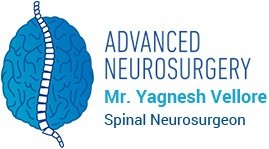Spondylosis
Spondylosis refers to the degenerative changes in the spine that may cause loss of the normal spinal structure and function. Spondylosis can occur in the cervical (neck), thoracic (mid-back), or lumbar (low back) regions of the spine. It is also known as osteoarthritis or degenerative joint disease.
Causes
The predominant cause of spondylosis is aging. As people age, the bones and cartilage in the spine gradually degenerate due to wear and tear, resulting in the formation of osteophytes (bone spurs). The degenerative changes can also weaken the intervertebral discs leading to bulging or herniated discs which can compress the nearby nerve roots or the spinal cord. Previous neck injuries and genetic factors appear to increase the risk of cervical spondylosis. The aging process also causes thickening of the spinal ligaments that may buckle with impingement into the spinal canal. A back injury or trauma, repetitive motions, poor postural habits, and excess body weight, may worsen spondylosis.
Symptoms
The symptoms of spondylosis depend on the segment of the spine affected. The common symptoms include morning back pain or stiffness, limited range of motion, weakness, numbness, or tingling sensation, abnormal gait, sciatica, cervical radiculopathy, muscle spasm, and a loss of bladder or bowel control in a few cases.
Diagnosis
An accurate diagnosis and an effective treatment plan are required for a successful treatment outcome. Your doctor diagnoses spondylosis based on your symptoms, medical history and the physical and neurological examination findings. Your doctor may also test your reflexes, sensations, and muscle strength. Diagnostic imaging tests such as X-rays, CT scans or MRI scans may be required to confirm the diagnosis. CT scans provide a detailed image of your bones while a MRI scan is useful in detecting nerve or spinal cord compression.
Treatment
Most cases of spondylosis are managed with non-surgical treatment without the need of a surgery. The non-surgical treatment options include bed rest, activity modification, anti-inflammatory and pain medications, muscle relaxants, spinal injections, bracing, physical therapy, and acupuncture. Generally, your doctor may combine two or more of these treatment modalities to increase the success of your treatment.
Surgical intervention may be considered for patients with an unstable spine or a neurological deficit, or those with persistent pain that do not respond to conservative measures. The aim of the surgery is to relieve the pressure over the nerves or spinal cord and to stabilize the spine. Spinal fusion and instrumentation may be performed to treat spinal instability. Patients with neurological deficit may require a minimally invasive spine surgery.
Your surgeon will discuss the surgical options and recommend the most appropriate option for you.

